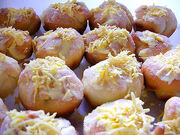关注健康
主要涉及食疗营养,菜肴烹制,饮品调制,果蔬种植,养花陶情,两性健康,中医及运动养生等。Ensaymada
From Recipes Wiki
Description
Ensaymada, a filipino sweet bread, is one of the many pastries derived from spanish origins. Ensaymada in fact are very much the same as their european counterpart, ensaimada, which are a pastry specialty of the Balearic Islands, most notably Mallorca (Majorca). Although it is a spanish specialty, the origin of the ensaimada can theoretically be traced to the arabic occupation of the Ibizan Peninsula from 740 to 1235 AD and the explorations of the arab world by the spanish and portuguese. One belief is that the pastry may have been castilian, as the root of the name, saín, is the castilian medieval word for lard, from which the sweet breads are commonly made today. However, the arabic word for 'butter' was saim, which seems to be a better fit for the name, and for the pastry, which was known to be made originally with butter. It is thought that the mallorcan pastries only were made with lard when the catholic church encouraged the use of Pork products to eradicate the arab indocrination of the region and to drive jews and arabs from the region altogether. Controversial stuff, this. However, by the time it got to the Philippines, the recipe had reverted to its butter-based origins. The original sweet bread is one large snail-like coil dusted in Sugar, but today individual sized cakes are more popular throughout the country. They are soft, buttery, milky and rich, and with the added slather of butter, Sugar, and Cheese, a sinful pillow of extravagance for your breakfast or tea.
Ingredients
- 3 1/2 to 4 teaspoonfuls of yeast
- 1/3 cup of lukewarm water
- 1 1/2 teaspoonfuls of white sugar
- 1/2 cup diluted evaporated milk or undiluted whole milk
- 1/2 cup white sugar
- 1/4 cup melted butter
- 3 egg yolks
- 2 1/2 to 3 cups unsifted all-purpose flour (after measuring sift flour)
Directions
- Grated mild white or yellow Cheese, white sugar, softened butter for top or filling.
- Dissolve the yeast in the lukewarm water and 1 1/2 teaspoonful of white sugar.
- Mix, then set aside until bubbly.
- Mix everything together until well incorporated and smooth.
- Transfer dough into a greased bowl, let rise for one hour, then form into a log, flatten out and fill with Cheese and butter (optional), or just coil into a snail shape in a greased pan.
- If you are making individual cakes, divide the dough in equal pieces, roll into logs and coil or knot and place in greased muffin tins.
- Let rise for another hour, then brush with butter and bake in a preheated 300˚F oven for 25 minutes or until lightly brown.
- Cool completely, slather with butter, dust with Sugar and top with grated Cheese, if desired. (http://recipes.wikia.com/wiki/Ensaymada)





